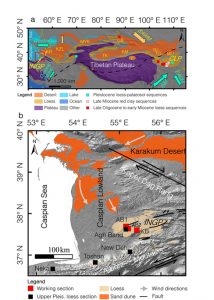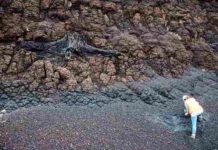
Famous for its deserts, arid central Asia (ACA) is one of the driest regions in the mid-latitudes and one of the main potential dust sources for the northern hemisphere. The mobilization, transportation, and deposition of Asian dust played an important role in global mineral dust cycles and had a prolonged and profound impact on global climate changes via direct effects on Earth’s radiative balance as well as by various indirect effects. Thus, reconstruction of the spatiotemporal history of aeolian dust and palaeoclimate in ACA is important for understanding the forcing mechanisms of palaeoclimatic changes in the Asian interior on various time-scales and for predicting future regional climate changes in semi-arid and arid regions under global warming.
The relationship between loess accumulation and long-term climatic history in ACA remained unclear until the present study was conducted, largely due the lack of in situ early Pleistocene loess/dust records in this remote region.
The lower Pleistocene loess in the northeastern Iranian Golestan Province (western ACA) and loess reported from south Tajikistan (central ACA) indicate that there was widespread loess accumulation in ACA during the early Pleistocene. Accumulation of loess is commonly associated with the occurrence of dust storms at the studied sites and the widespread distribution of loess is evidence that dust storms have become frequent in ACA at least since the early Pleistocene.
The transition from shallow marine sediments to loess deposits at ~2.4 Ma in the NIGP documents a dramatic change in the early Pleistocene from a region with a humid, marine-influenced climate to a semi-arid climate.
Fundamentally, the formation of widespread, thick loess deposits requires a substantial source area arid enough to generate aeolian particles, sufficient wind energy to transport the dust, and suitable geomorphological conditions for preserving the deposited dust. Therefore, the accumulation of loess deposits in the NIGP at ~2.4 Ma suggests that an arid environment had formed in the source regions, such as the Karakum Desert and the Caspian Lowland, during the early Pleistocene. This remarkable early Pleistocene aridification in western ACA is broadly consistent with the onset of aridification in central ACA, the expansion of the Taklimakan Desert in northwestern China, and intensified aridification in northeastern China. This suggests that a semi-arid to arid environment developed within a large region of mid-latitude Asia in the early Pleistocene.
Alternations of loess layers and palaeosols in the NIGP document long-term alaeoclimatic changes in western ACA, which are reflected by colour variations. Sedimentological analysis confirmed that the widespread red-coloured sediments underlying the upper Pleistocene loess in the northeastern Golestan are aeolian in origin. Since they are located downwind on the periphery from the potential dust sources of the Karakum Desert and the Caspian Lowland, and are far from areas affected by major glaciations, these deposits on the NIGP are undoubtedly “desert” loess.
Moreover, this idea received further support from the analysis of grain size and thickness of the last glacial loess and the comparison of geochemical signatures of the lower and upper Pleistocene LPS and modern loess.
It was concluded that the climate during the early Pleistocene in the NIGP was semi-arid, but wetter, warmer, and less windy than during the late Pleistocene and present interglacial. The orbital-scale palaeoclimatic changes in ACA were closely linked to the growth and decay of the northern hemisphere ice sheets. There are two possible causes of this relationship. First, the expansion of the ice sheets in the northern hemisphere resulted in cooling of the North Atlantic Ocean and enhanced continentality in the Asian interior. This would have reduced moisture transport to the continental interior and thus increased its aridity, resulting in the accumulation of loess deposits in ACA. An alternative interpretation is that the expansion of the ice sheets intensified the Mongolian-Siberian high-pressure system, which forced the southward migration of the zonal Westerlies which would have resulted in the enhanced incursion of cold air masses derived from high latitudes of Eurasia and reduced the influx of moisture from the Atlantic Ocean.
Reference:
Xin Wang et al. Early Pleistocene climate in western arid central Asia inferred from loess-palaeosol sequences, Scientific Reports (2016). DOI: 10.1038/srep20560
Note: The above post is reprinted from materials provided by Kazan Federal University.










